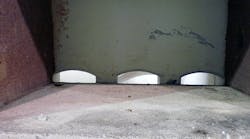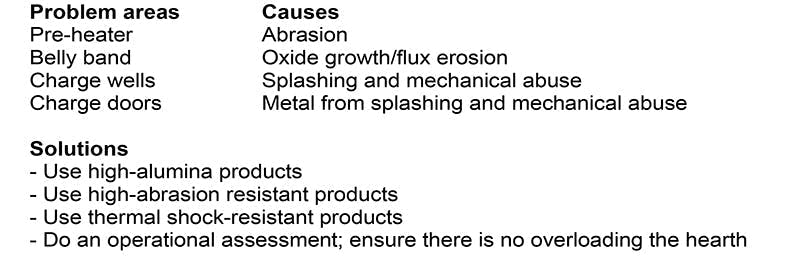There are many common challenges that occur with aluminum melting and holding furnaces, ladles and lauders. In this article, I will outline tailored solutions for the following melting equipment:
- Tower or stack melters
- High- and low-headroom reverberatory melters
- Dry hearth furnaces.
- Launders
- Ladles
Tower or stack melters
The critical issue on a stack melter occurs in the impact area, where scrap and ingots contact with the stack during loading from the lift hopper. This impact zone is prone to high wear. To mitigate this, it is recommended to employ abrasion-resistant refractories specifically designed for this area, such as:
- Impact pads
- SS needles in the refractory
- SS impact rails in the target area
Note that there is not a complete solution to this issue if the operator continually loads the stack when empty.
Other concerns on stack melters include the transition area from melter to holding chamber, and the square corners in the holding chamber. These can be addressed by installing phos-bonded, high-alumina material in the holding zone and adding a corner radius, to reduce both cracking and oxide build-up.
The hearth, at the bottom of the stack, is another concern, especially if the furnace tenders are constantly loading the furnace with the stack empty. That means scrap and ingots are falling 6-12 feet onto that hot refractory hearth. No refractory material can withstand that for very long.
The best solution to this problem is to never let the stack get empty, and for two reasons:
- Melting occurs at a much higher rate (as much as 1800 BTUs/# melted); and,
- It can help to increase the life of the refractory hearth.
Wet-bath reverberatory melters
Wet-bath melters, high head-room, or radiant-roof low-headroom melters have similar issues. Both types of units should have a preheat hearth at one end and a clean-out door at the other. The hearth, which can be used to preheat sows or ingots, will take some abuse over time. (NB: Do not cast the entire hearth with high-abrasion material.) Cast only the load-bearing areas with the more expensive, high-abrasion material.)
The belly band area – where the molten metal makes contact with oxygen – is where abrasion will take place on the sidewalls – especially if you are over fluxing with an oxide-removing flux.
Charge wells and doors must be cleaned daily, as the splashed-up metal should be removed as soon as possible to avoid a massive build-up. Scrape it off quickly into the bath and reuse it. The well should have the same refractory material as the inside walls below the metal line. Arch openings must be checked weekly to ensure they are not getting build-up that would decrease the square inches of the opening.
Dry hearth furnaces
The dry hearth is where most of the abuse will occur. Care should be taken to know exactly how much metal to place on that hearth at one time. The hot modulus of rupture for the refractory material should be taken into consideration when choosing this refractory. This will let you know the load or the refractory (psi lb. f/in2) can manage when hot. Always remove any dross on the hearth after melting before loading the next ingots or sows.
The divider wall is the hardest wall to clean in the furnace. This wall separates the melt zone (hearth) from the hold zone. You can clean the hold zone side pretty easily, but the dry hearth side is difficult unless there is an extra door on the side of the dry hearth to facilitate cleaning.
The openings in the divider wall should be sized so that no scrap or ingots can fall through them. A special tool should be designed to clean those openings, as any stuck metal that passes through them needs to be cleaned off on a daily basis. And never load the hearth to the point that ingots or sows are up against the divider wall.
Refractory should have SS needles in it to help hold the wall together. Some companies use structural tubing in the wall to air cool it and to add stability to the wall. Usually, the wall is only tied into the floor and sidewalls, which means it is the least stable wall in the furnace. Some manufacturers use a floating roof design which prohibits tying it into the roof, or they leave an opening at the top of the wall for the products of combustion to be exhausted through that flue.
Launder systems
Electrically heated launder systems have high heat very close to the metal and this can start the oxidation process very quickly. Because there is less volume of metal to super heat, they create very little dross per shift. Once oxide begins to grow, it will grow right up to the heat source and destroy the elements. This can be managed easily by cleaning the entire launder system daily.
Refractory choices really depend on the alloy you are laundering; keep this in mind when buying a launder system.
Transfer ladles
Transfer ladles need to be lined with an abrasion- and thermal-shock resistant material in the floor of the ladle where the metal being tapped into the ladle hits the refractory. Special care should be taken to always use a ladle preheated to 800 degrees F or higher. Never pour molten aluminum into a cold ladle. Many companies raise their melt temperature to compensate for the loss in temperature transferring the metal to the holding furnaces or to the mold. Ladles should have a microporous back-up lining to ensure the best insulating properties. This can result in lowering the melter temperature. Ladles should be scraped out while hot at the end of every shift to remove any contaminates and oxides.
These suggestions can result in a longer production life for your furnaces, launders, and ladles. Contact your refractory supplier or furnace manufacturer for exact material specifications for your particular application. Every month or year of extra life you gain from this equipment transfers positively to your bottom line.
David W. White is a consulting specialist in metalcasting technologies.










